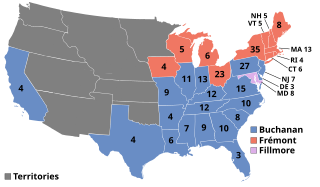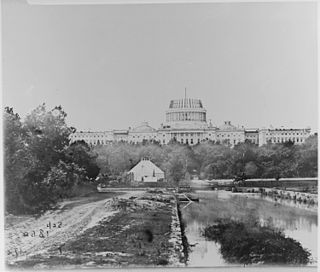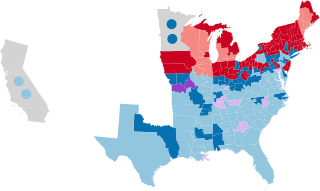
The 1856 United States presidential election was the 18th quadrennial presidential election, held on Tuesday, November 4, 1856. In a three-way election, Democrat James Buchanan defeated Republican nominee John C. Frémont and Know Nothing nominee Millard Fillmore. The main issue was the expansion of slavery as facilitated by the Kansas–Nebraska Act of 1854. Buchanan defeated President Franklin Pierce at the 1856 Democratic National Convention for the nomination. Pierce had become widely unpopular in the North because of his support for the pro-slavery faction in the ongoing civil war in territorial Kansas, and Buchanan, a former Secretary of State, had avoided the divisive debates over the Kansas–Nebraska Act by being in Europe as the Ambassador to the United Kingdom.
This section of the timeline of United States history concerns events from 1820 to 1859.

The 35th United States Congress was a meeting of the legislative branch of the United States federal government, consisting of the United States Senate and the United States House of Representatives. It met in Washington, D.C. from March 4, 1857, to March 4, 1859, during the first two years of James Buchanan's presidency. The apportionment of seats in the House of Representatives was based on the 1850 United States census. Both chambers had a Democratic majority.

Jesse David Bright was the ninth Lieutenant Governor of Indiana and U.S. Senator from Indiana who served as President pro tempore of the Senate on three occasions. He was the only senator from a Northern state to be expelled for being a Confederate sympathizer. As a leading Copperhead he opposed the Civil War. He was frequently in competition with Governor Joseph A. Wright, the leader of the state's Republican Party.

The 34th United States Congress was a meeting of the legislative branch of the United States federal government, consisting of the United States Senate and the United States House of Representatives. It met in Washington, D.C., from March 4, 1855, to March 4, 1857, during the last two years of Franklin Pierce's presidency. The apportionment of seats in the House of Representatives was based on the 1850 United States census. The Whig Party, one of the two major parties of the era, had largely collapsed, although many former Whigs ran as Republicans or as members of the "Opposition Party." The Senate had a Democratic majority, and the House was controlled by a coalition of Representatives led by Nathaniel P. Banks, a member of the American Party.

The 1856–57 United States House of Representatives elections were held on various dates in various states between August 4, 1856, and November 4, 1857. Each state set its own date for its elections to the House of Representatives. 236 representatives were elected in 31 states and the pending new state of Minnesota before the first session of the 35th United States Congress convened on December 7, 1857.

Elections in Missouri are held to fill various local, state and federal seats. Special elections may be held to fill vacancies at other points in time.

The 1856–57 United States Senate elections were held on various dates in various states. As these U.S. Senate elections were prior to the ratification of the Seventeenth Amendment in 1913, senators were chosen by state legislatures. Senators were elected over a wide range of time throughout 1856 and 1857, and a seat may have been filled months late or remained vacant due to legislative deadlock. In these elections, terms were up for the senators in Class 1.

The 1856 United States presidential election in Pennsylvania took place on November 4, 1856, as part of the 1856 United States presidential election. Voters chose 27 representatives, or electors to the Electoral College, who voted for president and vice president.

The 1856 United States House of Representatives election in Florida was held on Monday, October 6, 1856 to elect the single United States Representative from the state of Florida, one from the state's single at-large congressional district, to represent Florida in the 35th Congress. The election coincided with the elections of other offices, including the presidential election, the senatorial election, the gubernatorial election, and various state and local elections.

The 1856 United States elections elected the members of the 35th United States Congress and the President to serve from 1857 until 1861. The elections took place during a major national debate over slavery, with the issue of "Bleeding Kansas" taking center stage. Along with the 1854 elections, these elections occurred during the transitional period immediately preceding the Third Party System. Old party lines were broken; new party alignments along sectional lines were in the process of formation. The Republican Party absorbed the Northern anti-slavery representatives who had been elected in 1854 under the "Opposition Party" ticket as the second-most powerful party in Congress. Minnesota and Oregon joined the union before the next election, and elected their respective Congressional delegations to the 35th Congress.

The 1856 United States presidential election in Virginia took place on November 4, 1856, as part of the 1856 United States presidential election. Voters chose 15 representatives, or electors to the Electoral College, who voted for president and vice president.

The 1856 United States presidential election in Vermont took place on November 4, 1856, as part of the 1856 United States presidential election. Voters chose five representatives, or electors to the Electoral College, who voted for president and vice president.

The 1856 United States presidential election in Massachusetts took place on November 4, 1856, as part of the 1856 United States presidential election. Voters chose 13 representatives, or electors to the Electoral College, who voted for president and vice president.

The 1856 United States presidential election in Maine took place on November 4, 1856, as part of the 1856 United States presidential election. Voters chose eight representatives, or electors to the Electoral College, who voted for president and vice president.

The 1856 United States presidential election in New York took place on November 4, 1856, as part of the 1856 United States presidential election. Voters chose 35 representatives, or electors to the Electoral College, who voted for president and vice president.

The 1856 United States presidential election in Maryland took place on November 4, 1856, as part of the 1856 United States presidential election. Voters chose eight representatives, or electors to the Electoral College, who voted for president and vice president.

The 1856 United States presidential election in Ohio took place on November 4, 1856, as part of the 1856 United States presidential election. Voters chose 23 representatives, or electors to the Electoral College, who voted for president and vice president.

The 1856 United States presidential election in Illinois took place on November 4, 1856, as part of the 1856 United States presidential election. Voters chose 11 representatives, or electors to the Electoral College, who voted for president and vice president.

The 1856 United States presidential election in Michigan took place on November 4, 1856, as part of the 1856 United States presidential election. Voters chose six representatives, or electors to the Electoral College, who voted for president and vice president.